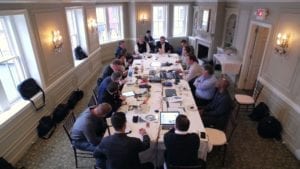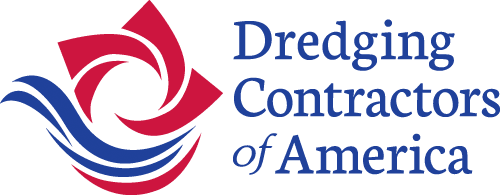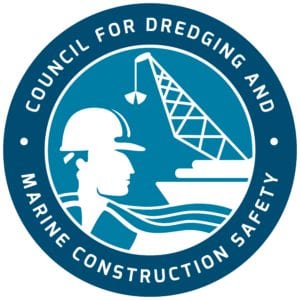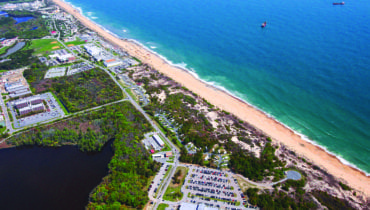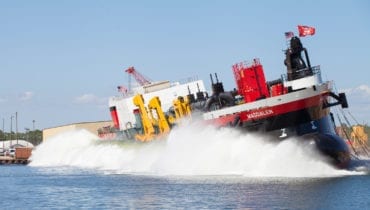The Council for Dredging and Marine Construction Safety (CDMCS) held its quarterly meeting in Washington, D.C. on February 7, with an excellent turnout from both the dredging industry and the U.S. Army Corps of Engineers (USACE). The agenda was dynamic and forward leaning, addressing hot topics with a variety of key stakeholders, including the United States Coast Guard (USCG), the National Safety Council (NSC), the American Waterways Operators (AWO), and Texas Water Infrastructure Network. CDMCS Co-Chair Devon Carlock was enthusiastic about the progress the group is making and thanked Michael Gerhardt, CDMCS Treasurer and Dredging Contractors of America Assistant Executive Director, for locking-in the keynote speakers and promoting the council at key industry meetings around the country. Mr. Carlock emphasized that…
“CDMCS is entering 2018 on an aggressive growth trajectory, leveraging its self-produced, professional hand safety awareness video; its modern, rebranded website replete with critical safety resources, and new key partnerships with federal agencies, national safety organizations, and leading manufacturers of safety equipment.”
New CEO & Executive Director of the DCA Highlights the Importance of Safety & Partnering with USACE
The new CEO & Executive Director of the Dredging Contractors of America (DCA), the Honorable William P. Doyle, was introduced by Mr. Gerhardt and gave his full support, stressing the importance of close cooperation with USACE. He also praised CDMCS for being the leader on safety for the industry and shared some of his own safety-related experiences of working at sea.
National Safety Council Addresses Fatigue Management
Emily Whitcomb, Senior Program Manager of The Fatigue Initiative at the National Safety Council, discussed workplace fatigue and its dangers. Mrs. Whitcomb spoke specifically about the construction industry and how fatigue definitely crosses over into maritime with very specific dangers. With fluctuations in work schedules, engine noise, and other multiple factors, the maritime and dredging industries have significant challenges to overcome. Mrs. Whitcomb offered to partner with the CDMCS on a fatigue initiative by reporting and sharing information between the two organizations.
USACE Shifts from Compliance to Risk Management
Mark Atkins, USACE HQ Chief of Safety, stressed USACE’s senior-level support for the CDMCS and was pleased to announce that USACE is shifting its safety approach from compliance to risk management. The CDMCS and dredging industry were enthusiastic to learn of this shift in safety culture at USACE. Atkins also said that USACE will publish a guide that will help contractors know how to get their APP’s approved more universally and consistently. Tiffany Burroughs, USACE HQ Coastal Program Manager, discussed USACE actions on the submerged utilities/pipelines issue. USACE’s Pipeline Location Observation Verification Enterprise Repository (PLOVER) is not active yet, for USACE is still working to resolve potential regulatory ramifications, legal issues and national security concerns. Perry Fowler of the Fowler Group Texas and the Texas Water Infrastructure Network, spoke on the importance of improving utility locations and agreed to partner with the CDMCS on this issue. Coastal and Marine Operators (CAMO) has agreed to speak at the next CDMCS quarterly meeting on May 16.
OSHA Update – Crane Operator Certification
Kevin Cannon, Senior Director of Safety & Health Services at the Associated General Contractors of America, updated the council on OSHA’s upcoming regulatory processes and actions. Crane operator certification and employer qualification deadline was extended to November of this year. A proposed rulemaking addressing the type & capacity issue for certification and the criteria for what it means to be “employer qualified” is forthcoming. OSHA is expected to keep the in-house employer training certification for contractors.
U.S. Coast Guard Briefs on SubChapter M
 Erik Johnson, National Towing Vessel Coordinator of the USCG’s Office of Commercial Vessel Compliance, discussed the new Subchapter M regulations by walking the group through the Towing Vessel National Center of Expertise website (www.dco.uscg.mil/tvncoe). Subchapter M regulations make inland towboats “inspected vessels”, and the compliance deadline is July 20 of this year. Companies will be allotted, however, a four-year timeframe to obtain certifications of inspection (COIs) for all their vessels at a rate of 25% each year. To comply, companies have the option to adopt a Towing Safety Management System (TSMS), which the USCG is advocating, or undergo USCG inspections. A vessel must operate under a TSMS for at least six months before it becomes eligible for a COI.
Erik Johnson, National Towing Vessel Coordinator of the USCG’s Office of Commercial Vessel Compliance, discussed the new Subchapter M regulations by walking the group through the Towing Vessel National Center of Expertise website (www.dco.uscg.mil/tvncoe). Subchapter M regulations make inland towboats “inspected vessels”, and the compliance deadline is July 20 of this year. Companies will be allotted, however, a four-year timeframe to obtain certifications of inspection (COIs) for all their vessels at a rate of 25% each year. To comply, companies have the option to adopt a Towing Safety Management System (TSMS), which the USCG is advocating, or undergo USCG inspections. A vessel must operate under a TSMS for at least six months before it becomes eligible for a COI.
Drug and Alcohol Testing Best Practices
Howard Cooper, Safety Manager-CSMS at The Dutra Group, discussed The Dutra Group’s changes in drug and alcohol testing policy. The group discussed ideas on how to further implement best practice testing procedures and reasonable suspicion techniques being used by some of the member companies. This is an area of safety that will receive much focus from the CDMCS in the weeks and months to come.
Digital Strategy for 2018
CEO Tyler Gray & Managing Director Rick Burchfield of Gray Street Solutions engaged the members in a digital strategy discussion for 2018. Increasing use of social media and news alerts, creating a Good Catch Page on the website with downloadable examples and video footage, publishing an annual report, and possibly creating a learning management system were all discussed.
“Our vision is steadfast in its dedication to creating a 100% injury-free workplace for the dredging and marine construction industry,” stated Michael Gerhardt. “The numbers show that by sharing best practices and fostering a safety-first culture, accidents and incidents can be reduced and our crews can go home safely. We invite any company that is serious about safety to please come join us, and make a difference.”
